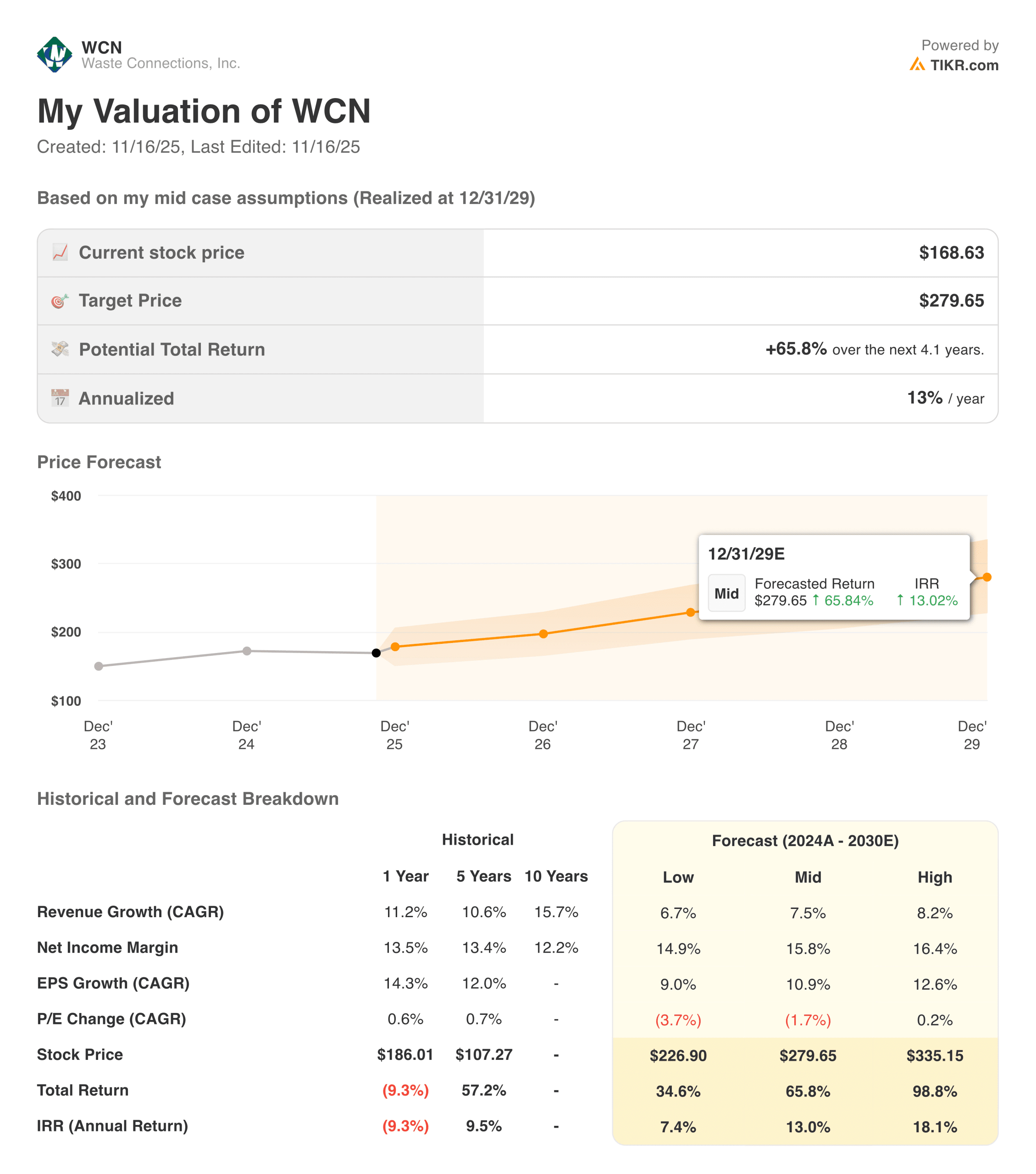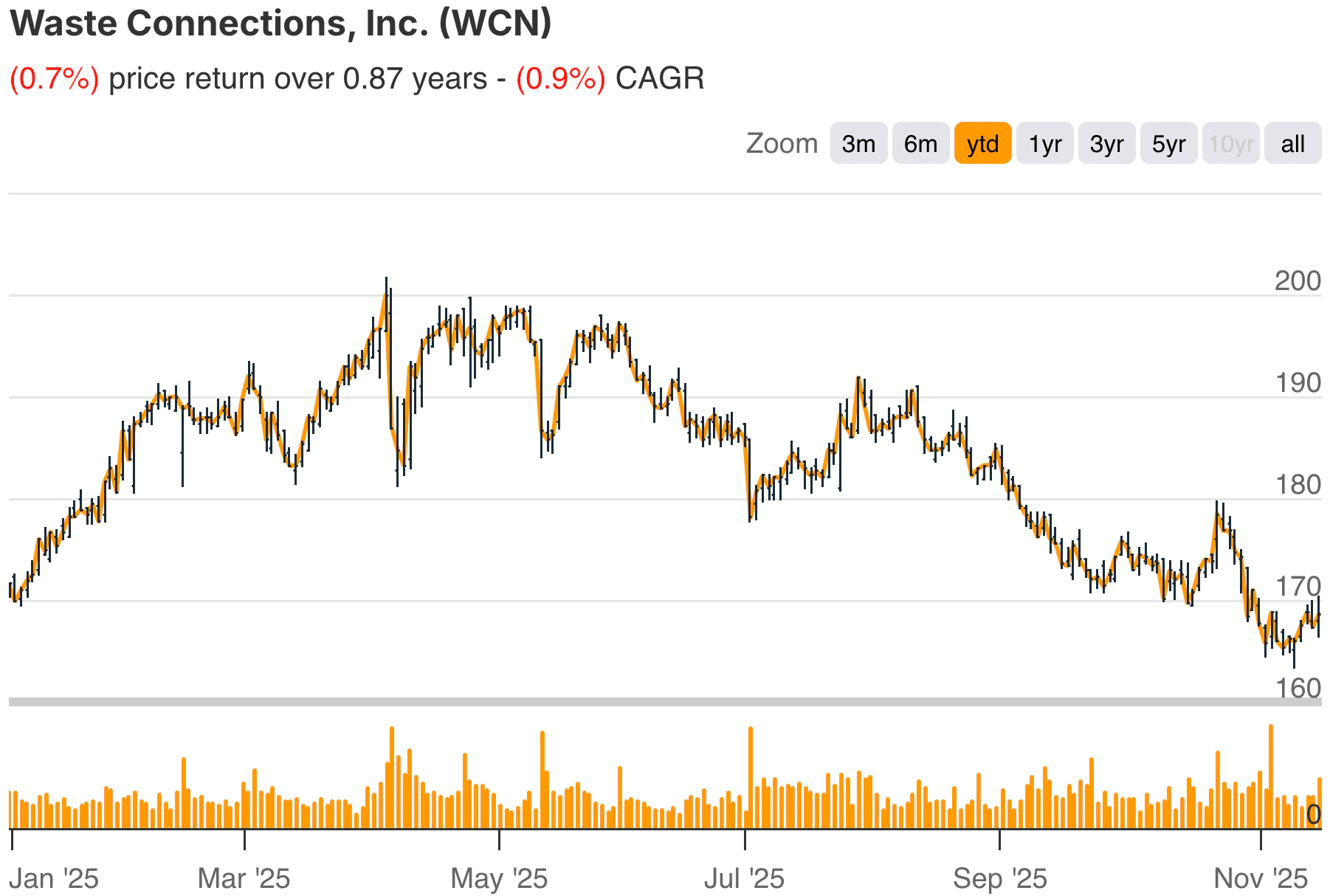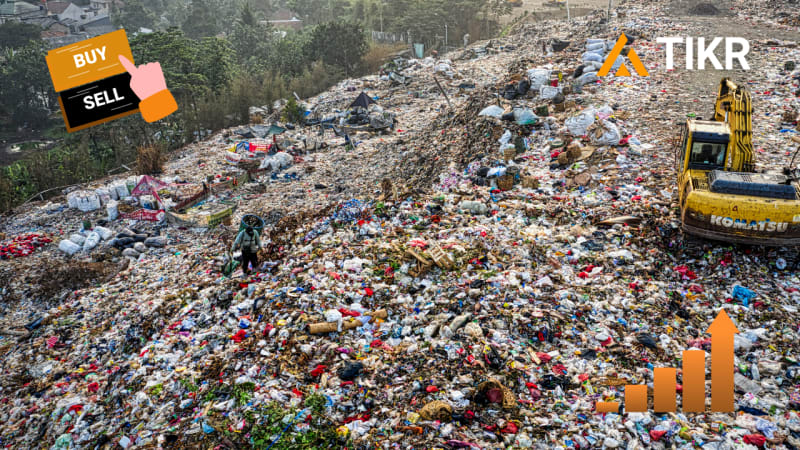Waste Connections (WCN) is one of the most stable businesses in the North American waste and environmental services space. The company benefits from a model built around essential services, long-term municipal contracts, and a network of operations in secondary and rural markets where competition is limited. This structure gives WCN an advantage during uncertain economic cycles. The business remains consistent, predictable, and focused on steady cash generation rather than rapid growth. That reliability has been one of the company’s defining traits over the past decade.
Find out what a stock’s really worth in under 60 seconds with TIKR’s new Valuation Model (It’s free)>>>
This year followed that familiar pattern, even though results landed in a mixed environment. Waste volumes were stable, pricing remained healthy, and the company continued benefiting from contracted revenue streams. On the other hand, commodity-sensitive revenue, such as recycled materials and renewable energy, remained volatile. The company also navigated shifts in disposal volumes and changes in certain end markets. Despite these pressures, WCN maintained steady margins and strengthened its core operations.

As 2026 approaches, the main question for investors is whether Waste Connections is positioned to regain momentum after a subdued 2025 stock performance. The early signs suggest a company that is operating from a position of strength. Pricing remained resilient, free cash flow is improving, and the company raised its dividend by eleven percent. These signals reflect confidence in long-term visibility. Waste Connections is not a rapid growth story, but it is a durable one. The foundation being built in 2025 appears to offer a smoother path into 2026.
Quickly value any stock with TIKR’s powerful new Valuation Model (It’s free!) >>>
Financial Story
Waste Connections generated $2.075 billion in revenue during the third quarter of 2025, up 6.4 percent year over year. Solid waste price growth reached 6.7 percent, led by a balanced mix of core price increases and positive contribution from rollover pricing. Volumes were essentially flat, which is a typical pattern in this industry when broader economic trends slow. Even so, the company delivered steady operational performance and maintained disciplined pricing, one of the most important levers in its business model.
| Metric | Q3 2025 | YoY Change |
|---|---|---|
| Revenue | 2.075B | +6.4% |
| Solid Waste Price Growth | +6.7% | Higher |
| Volume | Flat | — |
| Adjusted EBITDA | 650.8M | +6.9% |
| Adjusted EBITDA Margin | 31.4% | Slightly higher |
| Operating Income | 370.5M | Higher |
| Free Cash Flow | Higher | Improved |
| Dividend Increase | +11% | — |
Adjusted EBITDA grew 6.9 percent to 650.8 million dollars, and margins were stable. This consistency reflects the resilience of the company’s collection and disposal network. It also shows how Waste Connections manages inflationary pressure through pricing actions and operational control. Despite softness in certain categories such as recycled commodity revenue and renewable natural gas pricing, the company protected profitability and delivered predictable results.
Free cash flow improved meaningfully, and operating cash flow increased. Capital spending remained on track with full-year plans, and the company pointed to strong year-to-date cash conversion. Waste Connections also announced an eleven percent dividend increase, signaling confidence in its long-term financial position. While not a growth-oriented company, WCN continues to show why its model works so well in different economic environments. These Q3 results demonstrate a company that remains disciplined and well-positioned heading into next year.
Look up Waste Connections’ full financial results & estimates (It’s free) >>>
Broader Market Context
The waste industry remains one of the most defensive parts of the market. Municipal contracts, long-term franchise agreements, and steady residential and commercial collection create predictable revenue. Inflation has become a more manageable factor as companies like WCN have adjusted their pricing models to reflect new cost structures. The sector also continues to benefit from infrastructure spending, construction activity, and steady disposal demand.
At the same time, commodity exposure adds variability. Pricing for recycled fiber, metals, and renewable natural gas often swings from quarter to quarter. This has been a headwind in 2025, though less severe than in prior years. The key point is that these variables rarely alter the business’s long-term trajectory. Waste Connections has built a model that prioritizes stability over volatility, and that framework remains intact as the company moves toward 2026.
1. Pricing Strength Remains at the Center of the Model
Waste Connections relies heavily on pricing to drive revenue growth, and Q3 demonstrated why it remains a dependable pillar. Solid waste price growth came in at 6.7 percent, supported by strong core price actions and contracted roll-over adjustments. This level of pricing lifts revenue even when underlying volumes remain flat. It also offsets inflation, helps maintain margins, and supports predictable cash flow.
As 2026 approaches, pricing remains one of the most important tools the company has for protecting profitability. Municipal contracts and franchise agreements often include built-in escalators that help smooth inflationary cycles. This gives WCN a more reliable revenue base than many companies connected to broader economic cycles. Pricing power is not just a short-term advantage. It is a structural feature of the business.
2. Operational Consistency Supports Cash Generation
Operational performance remained steady across the company’s network. Collection routes, landfills, and transfer stations operated efficiently, supporting stable margins and stronger cash flow. This consistency reflects how the company manages labor, equipment, and route optimization. Even during periods of volume softness, WCN’s integrated network helps maintain a strong financial baseline.
The company’s free cash flow improvement this quarter highlights the benefits of that stability. As capital spending normalizes and operating cash flow continues to grow, Waste Connections enters 2026 with more financial flexibility. This flexibility allows the company to maintain shareholder returns, fund selective acquisitions, and reinforce the network’s long-term strength.
Value stocks like Waste Connections in less than 60 seconds with TIKR (It’s free) >>>
3. Dividend Growth Signals Long-Term Confidence
One of the clearest signals from management this quarter was the eleven percent increase in the dividend. Waste Connections has a long history of consistently raising its dividend. This increase reinforces that pattern and reflects confidence in the company’s long-term cash generation. Dividend growth has become part of the company’s identity, appealing to investors who want steady income backed by a durable business model.
The importance of this increase becomes clearer when seen in the context of 2025. The company had a mixed year from a stock performance perspective, but operational performance remained solid. Raising the dividend at this stage shows management believes the business is positioned for continued stability. This confidence matters as Waste Connections prepares for 2026.
The TIKR Takeaway

TIKR shows a company that remains one of the most stable operators in the industry. Multi-year results highlight steady pricing, consistent margins, and reliable cash generation. These traits help Waste Connections stand out among essential services companies. As the company moves toward 2026, TIKR’s long-term charts make it clear that the foundation remains strong.
Should You Buy, Sell, or Hold Waste Connections Stock in 2025?
Waste Connections remains a steady operator with a long track record of consistent performance. The company continues to show reliable pricing, solid margins, and predictable cash generation, which helps support its long-term appeal. Investors who value stability will see familiar strengths, while those looking for faster growth may view the story differently. As the company moves toward 2026, the focus stays on execution, cash flow, and the durability of its core operations.
How Much Upside Does Waste Connections Stock Have From Here?
With TIKR’s new Valuation Model tool, you can estimate a stock’s potential share price in under a minute.
All it takes is three simple inputs:
- Revenue Growth
- Operating Margins
- Exit P/E Multiple
If you’re not sure what to enter, TIKR automatically fills in each input using analysts’ consensus estimates, giving you a quick, reliable starting point.
From there, TIKR calculates the potential share price and total returns under Bull, Base, and Bear scenarios so you can quickly see whether a stock looks undervalued or overvalued.
Find out what your favorite stocks are really worth (Free with TIKR) >>>
Looking for New Opportunities?
- See what stocks billionaire investors are buying so you can follow the smart money.
- Analyze stocks in as little as 5 minutes with TIKR’s all-in-one, easy-to-use platform.
- The more rocks you overturn… the more opportunities you’ll uncover. Search 100K+ global stocks, global top investor holdings, and more with TIKR.
Disclaimer:
Please note that the articles on TIKR are not intended to serve as investment or financial advice from TIKR or our content team, nor are they recommendations to buy or sell any stocks. We create our content based on TIKR Terminal’s investment data and analysts’ estimates. Our analysis might not include recent company news or important updates. TIKR has no position in any stocks mentioned. Thank you for reading, and happy investing!








